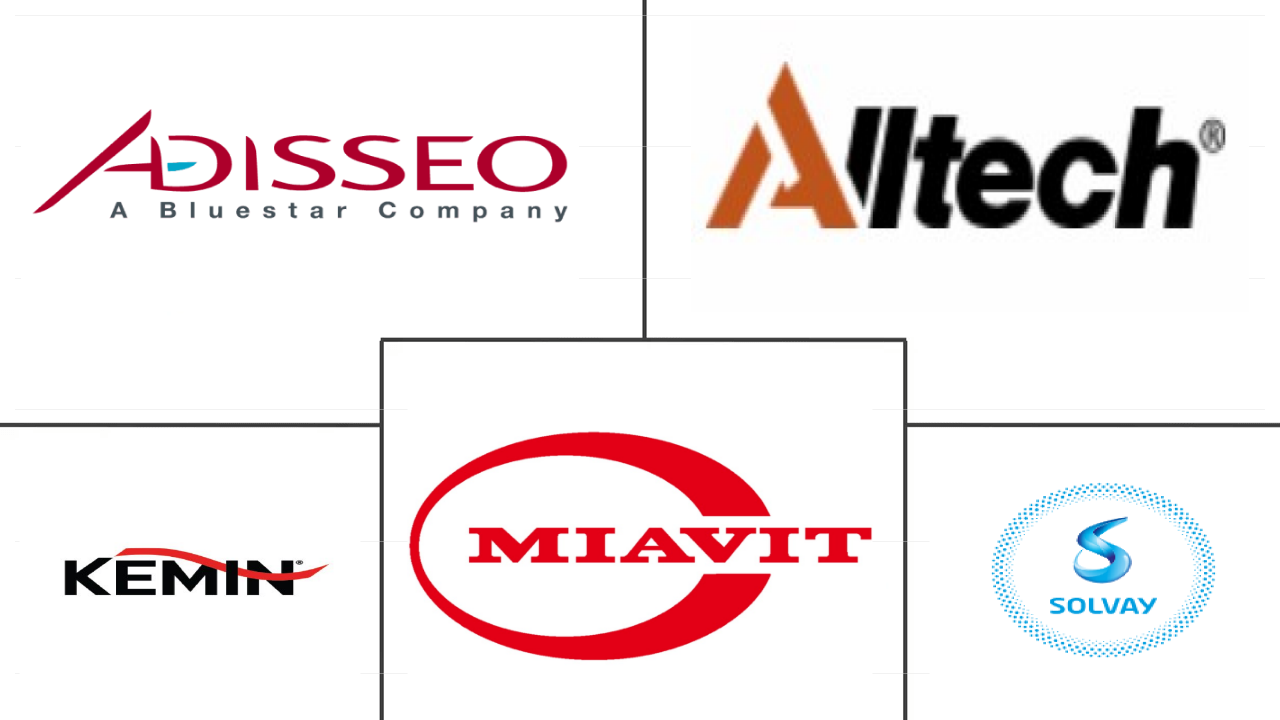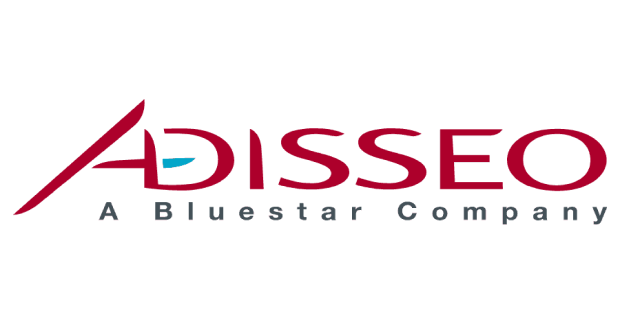Market Size of feed antioxidants Industry
| Icons | Lable | Value |
|---|---|---|
|
|
Study Period | 2017 - 2029 |
|
|
Market Size (2024) | USD 1.32 Billion |
|
|
Market Size (2029) | USD 1.73 Billion |
|
|
Largest Share by Sub Additive | Citric Acid |
|
|
CAGR (2024 - 2029) | 5.52 % |
|
|
Largest Share by Region | Asia-Pacific |
|
|
Market Concentration | Low |
Major Players |
||

|
||
|
*Disclaimer: Major Players sorted in no particular order |
Feed Antioxidants Market Analysis
The Feed Antioxidants Market size is estimated at 1.32 billion USD in 2024, and is expected to reach 1.73 billion USD by 2029, growing at a CAGR of 5.52% during the forecast period (2024-2029).
1.32 Billion
Market Size in 2024 (USD)
1.73 Billion
Market Size in 2029 (USD)
5.85 %
CAGR (2017-2023)
5.52 %
CAGR (2024-2029)
Largest Market by Sub-Additive
34.49 %
value share, Citric Acid, 2023
Citric Acid is the largest segment as it reduces the colonization of pathogens, improves protein content, and serves as a substrate in intermediary metabolism.
Largest Market by Region
31.21 %
value share, Asia-Pacific, 2023
Asia-Pacific has the largest share of the market because of the increase in the demand for increasing shelf life of feed and the higher poultry population in the region.
Fastest-growing Market by Sub-Additive
5.71 %
Projected CAGR, Propyl Gallate, 2024-2029
Propyl Gallate has witnessed the fastest growth in the market as it can protect fats and fat-containing feed from rancidity due to the formation of peroxides.
Fastest-growing Market by Region
6.44 %
Projected CAGR, North America, 2024-2029
North America is the fastest-growing segment as it increases the feed's shelf life by preventing autooxidation, leading to growth in the demand for antioxidants from poultry farmers.
Leading Market Player
11.75 %
market share, Adisseo, 2022

Adisseo is the market leader due to its strong research capabilities and established a new research facility in Singapore to produce innovative products, including antioxidants.
- The global feed additive market is witnessing significant growth, with feed antioxidants holding a 3.6% share. The oxidation process in animal feed results in a loss of nutritional value. As a result, feed antioxidants are added to prevent oxidation, thus increasing the shelf life of animal feed.
- Citric acid is the most popular antioxidant, accounting for a market value of USD 410.3 million, or a 1.2% share, in 2022. It is known for improving feed conversion ratios, increasing body weight, and reducing pathogen colonization in the intestine. Butylated hydroxyanisole (BHA) and Butylated hydroxytoluene (BHT) are the second and third-largest antioxidant type segments, with market values of USD 286.1 million and USD 213.8 million, respectively, in 2022. These antioxidants are mainly used in the poultry animal segment, which accounted for shares of 44.7% and 43.8% in the Butylated hydroxyanisole (BHA) and Butylated hydroxytoluene (BHT) type segments, respectively, by value in 2022.
- The expanding popularity of mold inhibitors and rising customer preferences for high-quality animal feed will provide profitable growth opportunities for antioxidants in the future. Ethoxyquin is emerging as one of the fastest-growing segments, expected to record a CAGR of 5.5% during the forecast period, owing to its higher feed conversion rate.
- The growing feed production globally, which rose by 19.3% between 2017 and 2022, reaching 1.25 billion metric tons in 2022, is one of the primary factors driving the feed antioxidant market, which is expected to record a CAGR of 5.5% during the forecast period (2023-2029).
- The global feed antioxidant market is expected to grow at a steady pace in the coming years. The Asia-Pacific region is expected to lead the market. In 2022, the Asia-Pacific region accounted for a market value of USD 371.8 million, with China being the largest consumer of feed antioxidants and accounting for 44.6% of the regional market share. The poultry segment holds a share of 49.3% in the antioxidants market, followed by swine feed, which holds 31.4% of the market share. This growth can be attributed to the increased production and consumption of meat in the region. Meat consumption in India increased by 16% during 2017-2021 and accounted for 4.1 thousand metric tons in 2021.
- North America is the fastest-growing region in the global feed antioxidants market. The region is expected to witness a CAGR of 6.4% during the forecast period. There was a 30.2% increase in feed production during 2017-2022. In North America, the United States is the largest market. It accounted for 70.2% of the regional market share in 2022.
- Spain is the largest market in Europe. It accounted for 16.5% of the market share in 2022, followed by France and Germany, which accounted for market shares of 14.3% and 13.6%, respectively. Citric acid and butylated hydroxyanisole (BHA) are the largest market sub-segments in Europe, and they accounted for 34.1% and 21.6% of the market share, respectively, in 2022.
- South America is an emerging market that is expected to record a CAGR of 5.2% during the forecast period. The rising cost of feed is driving the demand for feed antioxidants to prevent spoilage and extend the shelf life of products.
- The global market is expected to record steady growth, driven by rising meat consumption, feed production, and demand to maintain good quality and shelf life.
Feed Antioxidants Industry Segmentation
Butylated Hydroxyanisole (BHA), Butylated Hydroxytoluene (BHT), Citric Acid, Ethoxyquin, Propyl Gallate, Tocopherols are covered as segments by Sub Additive. Aquaculture, Poultry, Ruminants, Swine are covered as segments by Animal. Africa, Asia-Pacific, Europe, Middle East, North America, South America are covered as segments by Region.
- The global feed additive market is witnessing significant growth, with feed antioxidants holding a 3.6% share. The oxidation process in animal feed results in a loss of nutritional value. As a result, feed antioxidants are added to prevent oxidation, thus increasing the shelf life of animal feed.
- Citric acid is the most popular antioxidant, accounting for a market value of USD 410.3 million, or a 1.2% share, in 2022. It is known for improving feed conversion ratios, increasing body weight, and reducing pathogen colonization in the intestine. Butylated hydroxyanisole (BHA) and Butylated hydroxytoluene (BHT) are the second and third-largest antioxidant type segments, with market values of USD 286.1 million and USD 213.8 million, respectively, in 2022. These antioxidants are mainly used in the poultry animal segment, which accounted for shares of 44.7% and 43.8% in the Butylated hydroxyanisole (BHA) and Butylated hydroxytoluene (BHT) type segments, respectively, by value in 2022.
- The expanding popularity of mold inhibitors and rising customer preferences for high-quality animal feed will provide profitable growth opportunities for antioxidants in the future. Ethoxyquin is emerging as one of the fastest-growing segments, expected to record a CAGR of 5.5% during the forecast period, owing to its higher feed conversion rate.
- The growing feed production globally, which rose by 19.3% between 2017 and 2022, reaching 1.25 billion metric tons in 2022, is one of the primary factors driving the feed antioxidant market, which is expected to record a CAGR of 5.5% during the forecast period (2023-2029).
| Sub Additive | |
| Butylated Hydroxyanisole (BHA) | |
| Butylated Hydroxytoluene (BHT) | |
| Citric Acid | |
| Ethoxyquin | |
| Propyl Gallate | |
| Tocopherols | |
| Other Antioxidants |
| Animal | |||||||
| |||||||
| |||||||
| |||||||
| Swine | |||||||
| Other Animals |
| Region | ||||||||||||||
| ||||||||||||||
| ||||||||||||||
| ||||||||||||||
| ||||||||||||||
| ||||||||||||||
|
Feed Antioxidants Market Size Summary
The Feed Antioxidants Market is experiencing robust growth, driven by the increasing demand for high-quality animal feed and the need to prevent nutritional loss due to oxidation. Feed antioxidants play a crucial role in extending the shelf life of animal feed, with citric acid being the most widely used due to its benefits in improving feed conversion ratios and reducing pathogen colonization. The market is characterized by a diverse range of antioxidant types, including Butylated Hydroxyanisole (BHA) and Butylated Hydroxytoluene (BHT), which are predominantly utilized in the poultry segment. The rising popularity of mold inhibitors and the growing consumption of meat, particularly poultry, are expected to create lucrative opportunities for market expansion. The Asia-Pacific region, led by China, is a significant consumer of feed antioxidants, with North America also showing rapid growth, particularly in the United States.
The global feed antioxidants market is poised for steady growth, supported by the increasing production of feed and the expanding aquaculture industry. The demand for fish feed, in particular, is on the rise, driven by the need to enhance the performance of aquatic animals and meet the growing seafood consumption. South America is emerging as a key market, with significant increases in feed production aligned with the expansion of aquaculture farming. The market is fragmented, with major players like Adisseo, Alltech, Inc., Kemin Industries, MIAVIT Stefan Niemeyer GmbH, and Solvay S.A. actively expanding their presence and capabilities. Strategic initiatives, such as facility expansions and distribution partnerships, are being undertaken to enhance market reach and service quality, further fueling the growth of the feed antioxidants market.
Feed Antioxidants Market Size - Table of Contents
-
1. MARKET SEGMENTATION (includes market size in Value in USD and Volume, Forecasts up to 2029 and analysis of growth prospects)
-
1.1 Sub Additive
-
1.1.1 Butylated Hydroxyanisole (BHA)
-
1.1.2 Butylated Hydroxytoluene (BHT)
-
1.1.3 Citric Acid
-
1.1.4 Ethoxyquin
-
1.1.5 Propyl Gallate
-
1.1.6 Tocopherols
-
1.1.7 Other Antioxidants
-
-
1.2 Animal
-
1.2.1 Aquaculture
-
1.2.1.1 By Sub Animal
-
1.2.1.1.1 Fish
-
1.2.1.1.2 Shrimp
-
1.2.1.1.3 Other Aquaculture Species
-
-
-
1.2.2 Poultry
-
1.2.2.1 By Sub Animal
-
1.2.2.1.1 Broiler
-
1.2.2.1.2 Layer
-
1.2.2.1.3 Other Poultry Birds
-
-
-
1.2.3 Ruminants
-
1.2.3.1 By Sub Animal
-
1.2.3.1.1 Beef Cattle
-
1.2.3.1.2 Dairy Cattle
-
1.2.3.1.3 Other Ruminants
-
-
-
1.2.4 Swine
-
1.2.5 Other Animals
-
-
1.3 Region
-
1.3.1 Africa
-
1.3.1.1 By Country
-
1.3.1.1.1 Egypt
-
1.3.1.1.2 Kenya
-
1.3.1.1.3 South Africa
-
1.3.1.1.4 Rest of Africa
-
-
-
1.3.2 Asia-Pacific
-
1.3.2.1 By Country
-
1.3.2.1.1 Australia
-
1.3.2.1.2 China
-
1.3.2.1.3 India
-
1.3.2.1.4 Indonesia
-
1.3.2.1.5 Japan
-
1.3.2.1.6 Philippines
-
1.3.2.1.7 South Korea
-
1.3.2.1.8 Thailand
-
1.3.2.1.9 Vietnam
-
1.3.2.1.10 Rest of Asia-Pacific
-
-
-
1.3.3 Europe
-
1.3.3.1 By Country
-
1.3.3.1.1 France
-
1.3.3.1.2 Germany
-
1.3.3.1.3 Italy
-
1.3.3.1.4 Netherlands
-
1.3.3.1.5 Russia
-
1.3.3.1.6 Spain
-
1.3.3.1.7 Turkey
-
1.3.3.1.8 United Kingdom
-
1.3.3.1.9 Rest of Europe
-
-
-
1.3.4 Middle East
-
1.3.4.1 By Country
-
1.3.4.1.1 Iran
-
1.3.4.1.2 Saudi Arabia
-
1.3.4.1.3 Rest of Middle East
-
-
-
1.3.5 North America
-
1.3.5.1 By Country
-
1.3.5.1.1 Canada
-
1.3.5.1.2 Mexico
-
1.3.5.1.3 United States
-
1.3.5.1.4 Rest of North America
-
-
-
1.3.6 South America
-
1.3.6.1 By Country
-
1.3.6.1.1 Argentina
-
1.3.6.1.2 Brazil
-
1.3.6.1.3 Chile
-
1.3.6.1.4 Rest of South America
-
-
-
-
Feed Antioxidants Market Size FAQs
How big is the Global Feed Antioxidants Market?
The Global Feed Antioxidants Market size is expected to reach USD 1.32 billion in 2024 and grow at a CAGR of 5.52% to reach USD 1.73 billion by 2029.
What is the current Global Feed Antioxidants Market size?
In 2024, the Global Feed Antioxidants Market size is expected to reach USD 1.32 billion.

